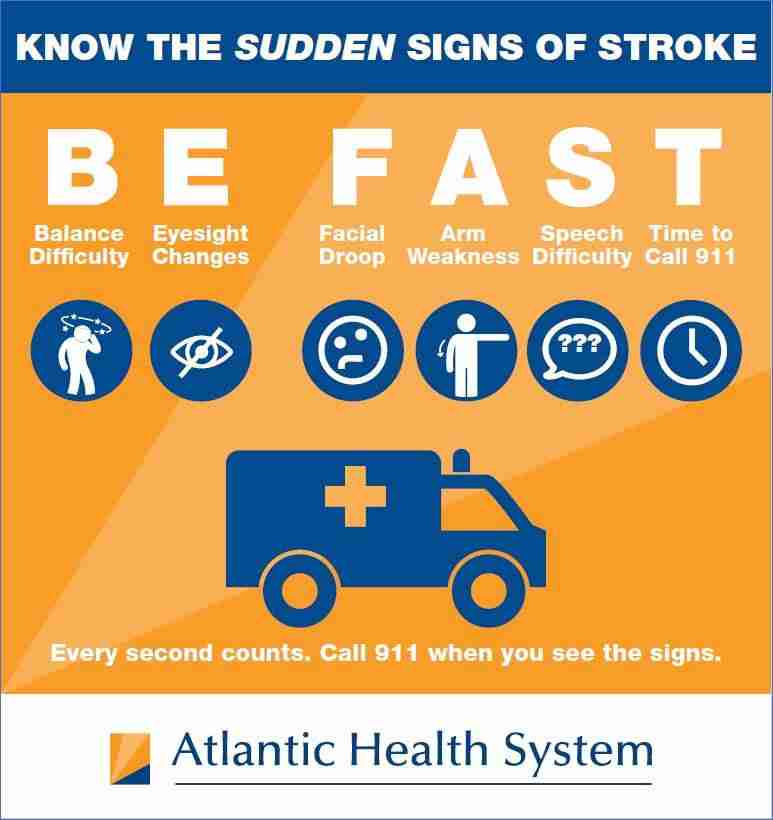
If you think a “mini-stroke” is a smaller version of a stroke, think again. A “mini-stroke”, medically known as a transient ischemic attack or TIA, describes the moment when a person begins to experience stroke symptoms. The only difference is — with a little bit of luck — a TIA will resolve itself.
“A TIA is a stroke that almost happened, but you never know if it’s a TIA or stroke until further evaluation is done with advanced imaging and a clinical assessment,” says John Hanna, MD, vascular neurologist and stroke medical director at Overlook Medical Center, part of Atlantic Health System, who believes the term “mini-stroke” is a little misleading. “It is a momentary episode of neurologic dysfunction caused by a blood vessel blockage in the brain, retina, or spinal cord, without evidence of permanent damage – and it needs immediate attention.”
Remember, there’s no way to know if the symptoms will resolve or worsen, so don’t try to wait-it-out or sleep-it-off. A TIA is a clear sign of what’s to come and is dangerous, even life-threatening, if left untreated.
Stroke Stats
According to the Mayo Clinic, about 1 in 3 adults who have a TIA will eventually have a stroke. And the greatest risk of stroke in TIA patients happens within the first three months of their TIA episode.
“These are sobering statistics, and people have the absolute power to prevent TIA and stroke by tackling the risk factors they can control,” says Dr. Hanna. “It starts with your primary care doctor who will help you to manage your health issues and make sure you have an appropriate treatment plan and medications.”
Make sure you’re managing these health conditions
- High blood pressure is the number one factor that increases future risk of stroke.
- An irregular heartbeat (AFib, Atrial Fibrillation) increases your stroke risk by 5.
- Heart failure increases your risk by 4.
- Coronary artery disease increases your risk by 2.
- Diabetes makes you 1½ to 3 times more likely to have a stroke.
- High cholesterol, kidney disease, peripheral arterial disease, obesity, smoking, alcohol consumption, obstructive sleep apnea all contribute to future TIA and stroke.
There are also some risk factors that are out of your control
- Age - The strongest determinant of future stroke, and risk increases as we get older
- Gender - Life-time risk of stroke is greater in woman than men since woman live longer than men on average
- Race - Data shows the highest risk of stroke among African-Americans and Latinos
- Genetics - Children are at greater risk if their parents have a history of stroke
Remember, every second counts when it comes to stroke, the key is to recognize the signs and symptoms, and act fast. “B.E.F.A.S.T. is a great guide for stroke awareness,” says Dr. Hanna. “It’s not just a list of symptoms, it also reminds us to be fast in our reaction time too.”
If you notice symptoms, call 911 immediately for on-site emergency care and transportation to the nearest hospital emergency room.
Know the Sudden Signs of Stroke
BE FAST is an easy way to remember and identify the most common symptoms of a stroke:
Balance – watch for sudden loss of balance
Eyes – check for blurry or loss of vision
Face – look for face drooping
Arm – check for arm weakness
Speech – listen for speech difficulty
Time – call 911 right away

Be Proactive About Your Health
To stay safe and healthy, it's good to have a primary care provider who knows and understands your health history and wellness goals.